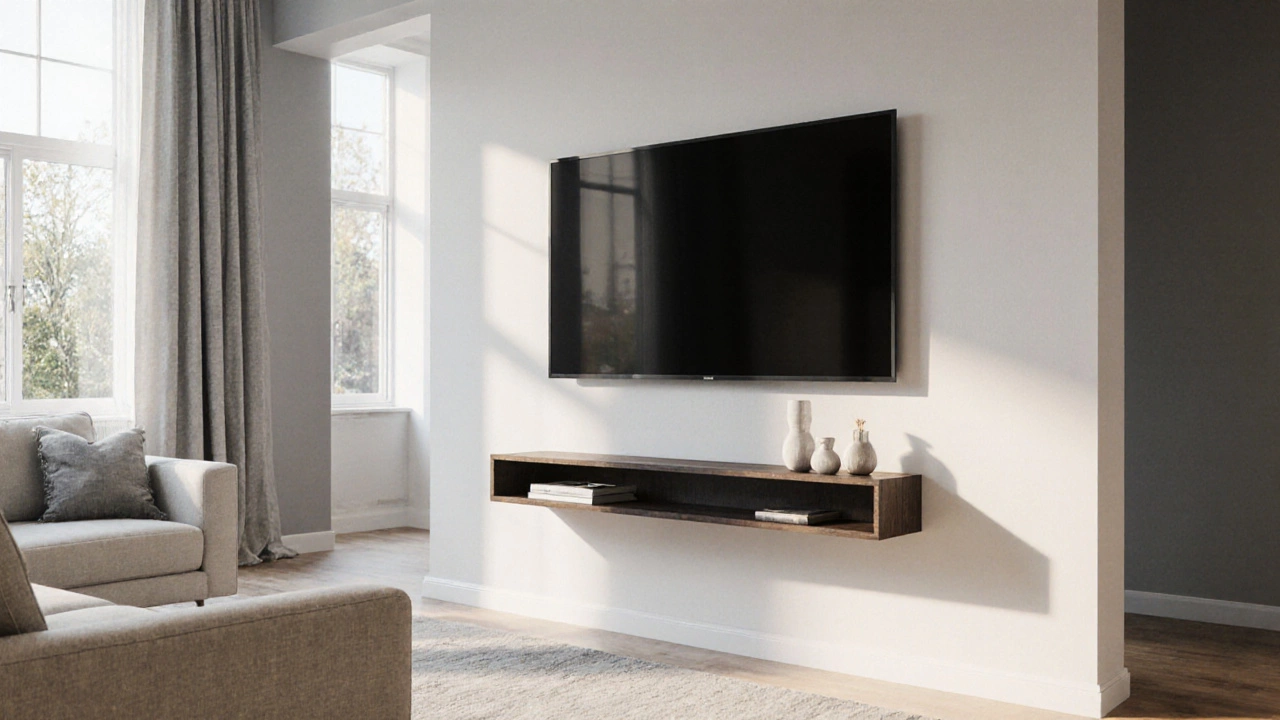
Creative Ways to Keep Your TV Up Without a Stand
Discover practical ways to keep your TV up without a stand. Learn wall‑mount, ceiling‑mount, floating shelf, and DIY options, plus safety tips and step‑by‑step guides.
When planning Secure TV Placement, the practice of installing a television so it stays safe, looks good and doesn’t damage anything around it. Also known as Safe TV Setup, it involves choosing the right furniture, mounting hardware and cable routes to keep both viewers and the device protected.
One of the first decisions is whether to use a traditional TV stand, a piece of furniture designed to hold a television at an appropriate height. Stands come in wood, metal or glass, and many include shelves for media players and décor. The benefit is easy mobility and no drilling, but you must check the stand’s weight limit and ensure it’s level to avoid wobbling. Choosing a sturdy stand can be a quick way to achieve secure TV placement without permanent changes.
If you prefer a cleaner look, a TV wall mount, a bracket that attaches the TV directly to a wall is the go‑to option. Wall mounts come in fixed, tilting and full‑motion styles, each affecting viewing angle and space usage. A fixed mount keeps the screen flush to the wall, which is ideal for low‑light rooms, while a full‑motion arm lets you pull the TV out for cleaning or adjust height for seated viewers. The mount must be anchored to studs or masonry, and the bracket’s VESA pattern must match the TV’s mounting holes.
Even with the right furniture or mount, messy cables can undo a tidy setup and create tripping hazards. That’s where cable management, systems like raceways, clips or sleeves that organize power and signal cords come in. Bundling cords behind a wall plate or routing them through a conduit keeps them hidden and reduces wear. Proper cable management also improves airflow around the TV, helping it stay cool and extending its lifespan.
Safety isn’t just about the TV itself; it’s about protecting the room’s furniture too. Anti‑tip straps secure the TV to the wall or stand, preventing it from toppling if bumped. For larger screens, consider a safety cable that attaches to a wall anchor. Secure mounting also respects the weight distribution: a 65‑inch TV can weigh upwards of 50 kg, so the bracket or stand must be rated for that load. Ignoring weight limits can lead to cracked brackets, damaged walls, or even a dangerous fall.
Ergonomics plays a big role in a comfortable viewing experience. The center of the screen should be at eye level when you’re seated, typically about 42‑inches from the floor for most adults. If the TV is too high, you’ll strain your neck; too low, and you’ll hunch over. Adjustable mounts let you fine‑tune the height, while a well‑chosen stand lets you add a riser or choose a model with the right seat height. Pairing the right height with proper viewing distance—roughly 1.5 to 2.5 times the screen diagonal—reduces eye fatigue.
Finally, think about the environment. In homes with kids or pets, a low‑profile stand or a wall‑mount positioned high on the wall adds an extra layer of protection. For rooms with lots of natural light, avoid glare by placing the TV away from direct sunlight or using anti‑glare screens. Moisture‑prone areas like basements benefit from a TV stand with raised feet to keep the unit off damp floors.
Below you’ll find a curated set of articles that dive deeper into each of these topics—from choosing the perfect TV stand and mastering cable management to selecting the right wall mount for your space. Explore the tips, tricks and product recommendations that will help you nail a safe, functional and stylish TV installation.

Discover practical ways to keep your TV up without a stand. Learn wall‑mount, ceiling‑mount, floating shelf, and DIY options, plus safety tips and step‑by‑step guides.